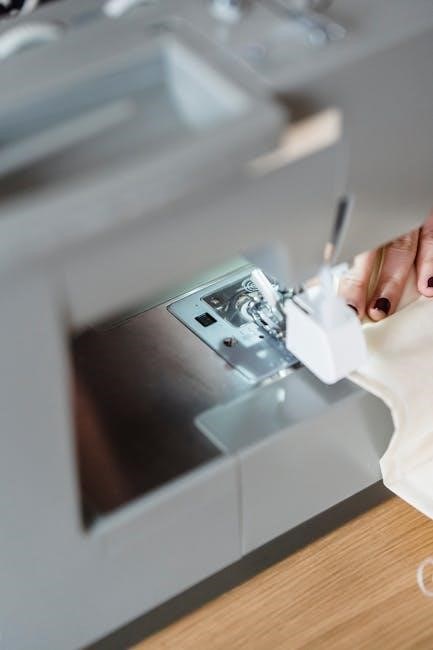Brother LS-2125 Sewing Machine Manual: A Comprehensive Guide
Welcome to your comprehensive guide to the Brother LS-2125 sewing machine! This manual will help you unlock the full potential of your machine, whether you’re a beginner or experienced. Clear instructions and helpful tips will guide you through everything, from threading to troubleshooting.
The Brother LS-2125 is a compact, mechanical sewing machine designed for basic sewing and mending tasks. Ideal for beginners and those seeking a straightforward machine, the LS-2125 offers a user-friendly experience with its intuitive controls and essential features. This guide will provide a comprehensive overview of the machine, covering everything from initial setup to advanced techniques.
This machine is a versatile tool, suitable for a range of sewing projects. With its free arm design, it’s particularly convenient for sewing cylindrical items like sleeves and pant hems. Its robust construction ensures durability and reliable performance, making it a valuable addition to any sewing room.
Whether you’re hemming pants, creating simple garments, or tackling craft projects, the Brother LS-2125 is designed to meet your needs. This manual aims to empower you with the knowledge and skills to use your machine effectively and confidently. We will explore the various features, functions, and maintenance tips to keep your machine running smoothly for years to come. Get ready to embark on your sewing journey with the Brother LS-2125!
Key Features and Specifications
The Brother LS-2125 boasts a range of features designed for ease of use and versatility. Its key specifications include a mechanical operation system, ensuring reliability and straightforward functionality. The machine features a free arm, which is invaluable for sewing cuffs, collars, and other cylindrical items. It also incorporates a four-step buttonhole function, simplifying the creation of buttonholes for garments and crafts.
Stitch selection is made easy with a clearly marked pattern selection dial. Users can choose from a variety of stitches, including zigzag, straight stitch, and satin stitch. The reverse sewing lever allows for easy backstitching, reinforcing seams and preventing unraveling. The machine includes essential accessories such as a buttonhole foot, zipper foot, and button sewing foot, expanding its capabilities for various sewing projects.

Furthermore, the LS-2125 features adjustable tension control, allowing users to fine-tune stitch quality based on fabric type. The built-in sewing light illuminates the workspace, providing better visibility for intricate tasks. Its compact design makes it easy to store and transport. With its combination of features and specifications, the Brother LS-2125 is a practical choice for both beginners and experienced sewers.
Understanding the Control Panel and Settings
The control panel of the Brother LS-2125 is designed for intuitive operation, allowing users to easily adjust settings and select desired functions. The most prominent feature is the pattern selection dial, which enables users to choose from a range of stitch patterns. Each stitch is clearly marked, making it simple to select the appropriate stitch for a specific sewing task. Adjacent to the pattern selection dial is the buttonhole fine-adjusting screw, used to customize buttonhole size and density.

The upper tension control dial is another crucial element, allowing users to regulate the tension of the upper thread. Adjusting this dial is essential for achieving balanced stitches, preventing puckering or loose threads. The reverse sewing lever, located conveniently for thumb operation, enables users to sew in reverse for reinforcing seams. Understanding the function of each control ensures optimal sewing results and prevents common issues.
The power switch, typically located on the side of the machine, controls both the main power and the built-in sewing light. Familiarizing yourself with these controls and settings is essential for mastering the Brother LS-2125 and achieving professional-looking results. By understanding how each control affects the sewing process, users can confidently tackle a wide variety of sewing projects.
Threading the Machine: Upper and Lower Thread
Correct threading is crucial for smooth sewing with the Brother LS-2125. Begin with the upper thread. First, place the spool of thread on the spool pin, ensuring it’s securely positioned. Guide the thread through the upper thread guides, following the numbered diagram on the machine. This ensures proper tension and prevents tangling. The thread then passes through the tension disc, which controls the thread tension. Next, guide the thread down and around the thread take-up lever, making sure it’s properly seated.
Finally, thread the needle from front to back. For the lower thread, start by winding the bobbin. Place the bobbin on the bobbin winder spindle and follow the diagram to wind the thread evenly. Once wound, insert the bobbin into the bobbin case, ensuring the thread feeds in the correct direction. Place the bobbin case into the shuttle race beneath the needle plate. Drawing up the lower thread involves holding the upper thread and turning the handwheel until the lower thread is pulled up through the needle plate.
Both threads should then be positioned under the presser foot, ready for sewing. Incorrect threading is a common cause of sewing problems; therefore, following these steps carefully will ensure smooth and successful sewing with your Brother LS-2125.
Bobbin Winding and Insertion
Winding the bobbin correctly is essential for seamless sewing with your Brother LS-2125. To begin, place the thread spool on the spool pin. Guide the thread around the bobbin winding tension disc, ensuring it sits snugly within the disc’s groove. This controls the thread tension during winding. Next, thread the end of the thread through one of the holes in the bobbin. Place the bobbin onto the bobbin winder spindle, pushing it firmly into place.
Engage the bobbin winder mechanism. Start the machine, and the bobbin will begin to wind. Once the bobbin is sufficiently full, the winding mechanism will often disengage automatically, or you’ll need to manually stop it. Remove the bobbin from the spindle and trim the excess thread. To insert the bobbin, first open the shuttle cover located beneath the needle plate. Remove the bobbin case by gently pulling the latch.
Place the bobbin into the bobbin case, ensuring that the thread feeds off the bobbin in the correct direction. Usually, this means the thread should unwind counter-clockwise. Thread the bobbin thread through the tension spring on the bobbin case, ensuring it clicks into place. Reinsert the bobbin case into the shuttle race until it locks securely. Close the shuttle cover. Your Brother LS-2125 is now ready for sewing with a properly wound and inserted bobbin.
Stitch Selection and Adjustment
The Brother LS-2125 offers a variety of stitch options to suit different sewing needs, each easily selectable using the pattern selection dial. This dial allows you to choose from utility stitches to decorative options; To select a stitch, simply turn the dial in either direction until the desired stitch number aligns with the indicator mark on the machine body. Consult the stitch chart printed on the machine or in the manual for a visual guide to each stitch.
The LS-2125 also allows for some stitch adjustments to fine-tune your sewing. While the machine has pre-set stitch lengths and widths for each pattern, understanding how these affect the final result is key. For example, adjusting stitch length can create denser or more spaced-out seams. These adjustments may be limited on the LS-2125, a mechanical model, but using different fabrics and threads can also significantly impact the appearance of your stitches.
Experiment with scrap fabrics to test different stitch settings before starting your main project. For buttonholes, the machine offers a 4-step automatic buttonhole function. Follow the manual’s instructions carefully for each step to achieve a balanced and well-formed buttonhole. Remember to always use the appropriate presser foot for the selected stitch, as this ensures proper fabric feed and stitch formation. Regular practice and experimentation will allow you to master stitch selection and adjustment on your Brother LS-2125.
Troubleshooting Common Issues
Even with careful use, you may encounter common issues with your Brother LS-2125. One frequent problem is thread breakage. This can be due to several factors, including incorrect threading, using the wrong type of thread for the fabric, or a damaged needle. Always re-thread the machine, ensuring the thread passes correctly through all guides and tension discs. Replace the needle with a new one of the appropriate size and type for your fabric.
Another common issue is the machine jamming or the fabric not feeding properly. This is often caused by lint or thread buildup in the bobbin area or feed dogs. Clean these areas thoroughly with a brush to remove any obstructions. Ensure the feed dogs are raised and not covered by a darning plate (if one is installed). Also, check that the presser foot is properly attached and exerting adequate pressure on the fabric.
Skipped stitches can occur if the needle is not correctly inserted or if the timing is off. Double-check that the needle is fully inserted and tightened. If the problem persists, the machine may require professional servicing. Uneven stitches or puckering can result from incorrect tension settings. Adjust the upper tension dial gradually, testing on scrap fabric until the stitches are balanced and smooth. If these steps don’t resolve the issue, consult the manual or seek assistance from a qualified technician.

Maintenance and Cleaning
Regular maintenance and cleaning are crucial for ensuring the longevity and optimal performance of your Brother LS-2125 sewing machine. Before any cleaning or maintenance, always turn off the machine and unplug it from the power outlet to prevent electrical shock.
The most important maintenance task is cleaning the bobbin area. Lint and thread fragments accumulate here, causing tension problems and skipped stitches. Remove the bobbin case and use a small brush or lint brush to gently clean the shuttle race, feed dogs, and surrounding areas. Avoid using canned air, as it can force debris further into the machine’s mechanisms. Occasionally, a drop of sewing machine oil can be applied to the shuttle race, following the manufacturer’s instructions.
Clean the exterior of the machine with a soft, damp cloth. Avoid using harsh chemicals or abrasive cleaners, as they can damage the finish. Regularly inspect the needle plate for scratches or burrs, which can snag fabric. Replace the needle plate if necessary. Check the needle clamp and presser foot for proper alignment and tightness. By following these simple maintenance steps, you can keep your Brother LS-2125 sewing machine running smoothly for years to come.
Available Manuals and Resources

To ensure you have access to all the information you need for your Brother LS-2125 sewing machine, several manuals and resources are available. The primary resource is the instruction manual, which provides detailed guidance on threading, stitch selection, troubleshooting, and basic maintenance. This manual is often available in PDF format for easy download and viewing on your computer or mobile device.
In addition to the instruction manual, you may find helpful videos online demonstrating various techniques and maintenance procedures specific to the LS-2125 model. Brother’s official website often provides support pages with FAQs and troubleshooting tips. Online sewing communities and forums can also be valuable resources for sharing experiences and getting advice from other LS-2125 users.
If you’ve lost your physical copy of the manual, websites like ManualsLib often host digital versions that you can download for free. Be sure to check for manuals specific to your model number, as there may be slight variations between LS-2125, LS-2125i, and other similar models. Utilizing these available resources will help you confidently operate and maintain your sewing machine.
